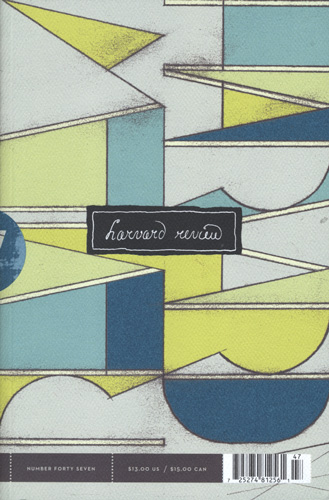Harvard Review – 2015
Harvard Review began life in 1986 as a four-page quarterly called Erato. Today it’s a 200+ page, perfect-bound semi-annual. Many Pulitzer Prize writers have been featured over the years, and this issue contains two Pulitzer nominees: Martín Espada, a 2006 finalist, who writes a tribute to his father in “The Shamrock,” and Cornelius Eady, a 1992 nominee. His poem “The Death of Robert Johnson” has these skilled, telling lines: “That that gal I kissed, / And her husband seeing that, / Was the fine print, / The way things get / Paid off.” Harvard Review began life in 1986 as a four-page quarterly called Erato. Today it’s a 200+ page, perfect-bound semi-annual. Many Pulitzer Prize writers have been featured over the years, and this issue contains two Pulitzer nominees: Martín Espada, a 2006 finalist, who writes a tribute to his father in “The Shamrock,” and Cornelius Eady, a 1992 nominee. His poem “The Death of Robert Johnson” has these skilled, telling lines: “That that gal I kissed, / And her husband seeing that, / Was the fine print, / The way things get / Paid off.”
The most unusual poem in this edition is Campbell McGrath’s “Gertrude Stein (1909).” McGrath has arranged eleven words into variations on a two-word sentence, bringing variety to the issue’s poetry. Other poems are equally memorable, like “Now That the Children Are Grown” by Joanna Solfrian, about children growing and the changes that brings.
Intervals of art throughout the magazine call for fixed attention. Cityscapes by Richard Raiselis have us seeing structures as though reflected in imperfect glass. Damian Stamer also interprets structures, though his small buildings are neglected and viewed through foregrounds of abstract brushwork.
The late renowned artist Robert Rauschenberg incorporated unexpected everyday objects—adhesive tape, clocks, a ladder—in some of his included works. My favorite among those pictured, mostly because I have a fondness for animals in the bovine kingdom, is “Gospel Yodel” from Rauschenberg’s Salvage series. This 1984 acrylic on canvas mixes words, a female figure, liquor labels, and, in the top right corner stands a magnificent bull. The art in this issue is monochromatic, and it’s effective in the magazine’s context. If you’re interested in seeing full color representations, check out the artists’ websites.
Of the five essays, some impressed me more than others because of their originality. Daniel Torday ties together blues, gospel music, and President McKinley’s assassination in a three-part essay titled “The White House Blues,” but most notable is “The Moth.” David McGlynn kept me wondering where the title came from. He begins his essay when he receives a Nintendo for his 11th birthday, then guides us through his parents’ divorce and an incident that prompted him to turn away from videogames. “That afternoon I became a reader in the way a kid splashing around a pool realizes he’s a swimmer [. . . ].” McGlynn asks, “What decides who we will become? What bolt of lightning from Mount Olympus transfigures any one of us into a reader or a gamer? A swimmer or a runner or a layabout?”
It may be a coincidence that what I feel are the best fictions have been saved for the last pages of this volume. In the penultimate story, “Expect No More,” by Kyle McCarthy, she describes how a writer named Alicia wavers between two men, Samuel and Eitan, while researching the life of Samuel’s father. Samuel invites her to stay at a hotel and McCarthy describes the scene with clarity. “‘So, you’ve got a boyfriend in New York,’ Samuel said, the next night, up on the roof. He reached for a lime wedge and poured out the last of the Bombay Sapphire. He had no compunctions; he owned the place.” Later, “Whenever he looked at me I sensed his recalibrations, as if he were rotating me slowly, trying to see every angle. Clearing his head so he could know me more.”
And what a pleasure to read the magazine’s final story, Martin Cloutier’s “Auntie Grandma,” about the relationship between the young restaurant worker Moshul and his recently deceased Great Aunt Vani: “Before he came to America, everyone warned Moshul that Vani was a marouny—a depraved woman, perhaps mentally unstable. [ . . . ] His relief could not have been greater when he encountered this proper lady in a turquoise sari, waiting for him with a pot of tea and a plate of cham-cham, one of this favorite sweets rolled in pink coconut powder.” A touching story, it’s a good choice to wrap up the issue.
This 47th edition of Harvard Review weighs close to a pound. With that in mind, find a comfortable chair, settle in, and enjoy this rich collection of poetry, art, essays and stories.
[harvardreview.fas.harvard.edu]





